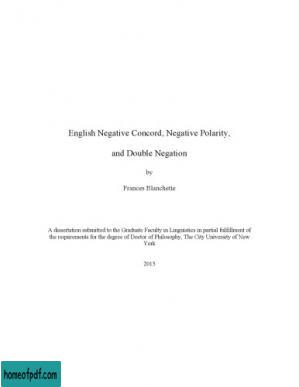English Negative Concord, Negative Polarity, and Double Negation
该资源由用户: 梓童来了 上传 举报不良内容

尊敬的读者:
欢迎您访问我们的网站。本站的初衷是为大家提供一个共享学习资料、交换知识的平台。每位用户都可以将文件上传至网盘并分享。
然而,随着用户上传的资料增多,我们发现部分不宜或版权问题的书籍被分享到了本站。
为此,我们已经关闭了分享入口,并进行了多次书籍审查,但仍有部分内容未能彻底审查到位。
在此,我们恳请广大读者与我们共同监督,如发现任何不宜内容,请 点击此处 进行举报,我们会第一时间处理并下架相关内容。
希望我们能共建一个文明社区!感谢您的理解与支持!
猜你喜欢

《给业余投资者的10条铁规》闲来一坐s话投资
View more
《给业余投资者的10条铁规》闲来一坐s话投资

《创业就是要细分垄断:互联网创业下半场机会路线图》李开复 等修订版
View more
《创业就是要细分垄断:互联网创业下半场机会路线图》李开复 等修订版

Dive Into Systems - Suzanne J. Matthews, Tia Newhall, and Kevin C. Webb
View more
Dive Into Systems - Suzanne J. Matthews, Tia Newhall, and Kevin C. Webb

The Hitchhiker’s Guide to Python - Kenneth Reitz and Tanya Schlusser
View more
The Hitchhiker’s Guide to Python - Kenneth Reitz and Tanya Schlusser

《数字战争:苹果、谷歌与微软的商业较量》[英]查尔斯·亚瑟 文字版
View more
《数字战争:苹果、谷歌与微软的商业较量》[英]查尔斯·亚瑟 文字版

《夏摩山谷》庆山修订版
View more
《夏摩山谷》庆山修订版

《宇宙超度指南》李诞修订版
View more
《宇宙超度指南》李诞修订版

《传播理论》赛佛林
View more
《传播理论》赛佛林

Docker for Rails Developers - Rob Isenberg
View more
Docker for Rails Developers - Rob Isenberg

《反套路》大卫·迪萨沃 文字版
View more
《反套路》大卫·迪萨沃 文字版

《人类成功统治地球的秘密》[美]约瑟夫·亨里奇/赵润雨全译版
View more
《人类成功统治地球的秘密》[美]约瑟夫·亨里奇/赵润雨全译版

《人人都在说谎 : 赤裸裸的数据真相》赛思·斯蒂芬斯--达维多维茨
View more
《人人都在说谎 : 赤裸裸的数据真相》赛思·斯蒂芬斯--达维多维茨


